4 Concepts
4.1 Overview
Projects, project management

4.1.1 General
The ultimate goal of a project is very simple: to make money or save money. Gary Heerkens
Figure 4-1 shows the context and environment of a project. A project can be independent or part of a program or portfolio.
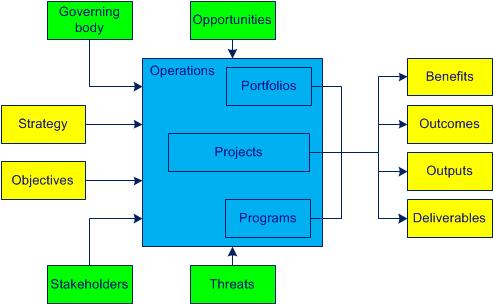
Figure 4-1. The project management environment
4.1.2 Projects
The work (operations) of each company aims to achieve the set objectives. The project is unique and temporary, while the operations are permanent and reproducible (manufacture a productany outcome of a process or activity (see also ISO 9000, 3.4.2), provide a service).
The objective of a project is to obtain results and make profits.
Some factors that contribute to differentiating projects are, for example:
- the context, the environment
- stakeholders
- objectives
- deliverables
- the resources
- constraints
- the methods
4.1.3 Project management
Project management includes practices to initiate, plan, manage, implement, control, monitor and close the project.
Resource management and team member motivation practices are part of all project management processes.
4.2 Context
Impacts, strategy, customers, suppliers, constraints, program and portfolio

4.2.1 Impact of context
To successfully carry out a project, you must understand and evaluate everything that can influence the performance of the project. It is appropriate to engage in reflection after a few essential activities:
- identify, understand and evaluate the needs of stakeholders (see § 4.5.10)
- analyze the factors (obstacles) that can influence the achievement of objectives
- draw up an in-depth diagnosis of the unique context in which the company finds itself, taking into account the issues (factors):
- external such as the environment:
- social
- regulatory
- economical
- technological
- competitive
- internal like:
- specific aspects of corporate culture:
- vision
- reason for being, purpose, mission
- essential values
- the needs and expectations of:
- workers
- stakeholders
- products and services
- infrastructure
- working conditions
- organization of work
- specific aspects of corporate culture:
- external such as the environment:
- regularly monitor and review any information relating to external and internal issues
PESTEL and SWOT analyses can be useful for a relevant analysis of the business context (see annex 08). 
In annex 08 you can also find tools for problem solving such as: 
- 5 W
- 8 D
- A 3
- Root cause analysis
- Fault tree analysis
- Brainstorming
A list of external and internal issues can be produced by a multidisciplinary team. Each issue is identified by its level of influence and control. Priority is given to issues that are very influential and not at all controlled.
4.2.2 Strategy
In business, strategy ought to mean just one thing: generating a sustainable competitive advantage. Robert Waterman
The strategic direction of the company is based on:
- the vision – our purpose (what we want to become)
- mission – our reason for being (what we do to achieve our vision)
- corporate culture - our values (what we believe in)
Any successful project contributes to creating added value by seizing opportunities and obtaining benefits for stakeholders and therefore contributes to the achievement of strategic objectives.
Added value for the company is created when the benefits of the project make investments profitable.
Entering the wonderful world of projects often means satisfying your ambitions and making your dreams come true.
Examples of opportunities:
- a need:
- from the customer
- of the company
- from the supplier
- market demand
- a legal requirement
In 1993, Microsoft launched the Encarta universal encyclopedia project, with the contribution of hundreds of individuals from around the world. The encyclopedia was sold on CD and DVD then on the Internet from 2000 and was available in eight languages. Encarta was shut down in 2009 because visits to its online encyclopedia in the United States were only 1.27% compared to 97% for Wikipedia.
Wikipedia is a general and multilingual encyclopedia created in 2001 under the GNU General Public License. It allows everyone to write and modify articles, hence its definition as a participatory encyclopedia or free work of massive non-profit collaboration. Wikipedia has become the most visited online encyclopedia in the world with more than 58 million articles in more than 300 languages.
For any project the contribution of millions of volunteers is an unbeatable force.
4.2.3 Customers and suppliers
This is exactly what I asked for, but it's not what I want. Customer
A project can be considered as coming from a customeranyone who receives a product (see also ISO 9000, 3.3.5) or a sponsor but also can be entrusted to a supplier or subcontractor. An example is the construction of roads, railways or a computer system.
Sometimes customer-supplier relationships are a source of confusion because these relationships are multi-directional.
In order to reduce conflicts, each part of the contract can identify:
- governance and its framework
- the structure of the project team
- project stakeholders
- working practices (linked to the project life cycle and its delivery)
Contract: a legally binding agreement between two or more parties that specifies the work to be performed, the deliverables to be produced, and the terms and conditions of the relationship
“In a typical business, if you have a meeting, no matter how important, there is always one party that is not represented: the customer. It is therefore very easy within the company to forget the customer.” Jeff Bezos.
To remedy this problem of forgetting, he got into the habit of placing an empty chair at each meeting.
4.2.4 Constraints
Project outcomes are often dependent on the following constraints:
- the delivery date of the project
- the allocated budget
- the availability of:
- financing
- people
- material resources
- the safety and health of personnel
- the level of acceptable risk
- the social, environmental and ecological impacts of the project
- the requirements of laws and regulations
- quality standards
Budget: estimate of all project expenses and revenues
Constraints are often interdependent; understanding them and reviewing them regularly is a prerequisite for the success of every project.
Creating a list of constraints by priority is an advantage in order to make the right decisions at the right time.
4.2.5 Project, program and portfolio
A project can be independent, part of a program or a portfolio, cf. ISO 21503 and ISO 21504 (§ 2.1).
As shown in figure 4-2, when the project is part of a portfolio or program, its objectives and governance are aligned directly to the portfolio or program.
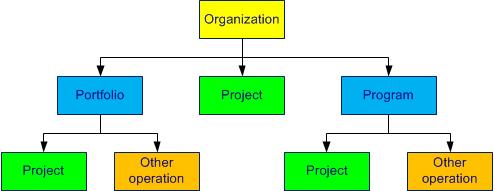
Figure 4-2. The project, program and portfolio
.jpg) Minute of relaxation. Cf. game: Context of the company
Minute of relaxation. Cf. game: Context of the company
Framework, business case
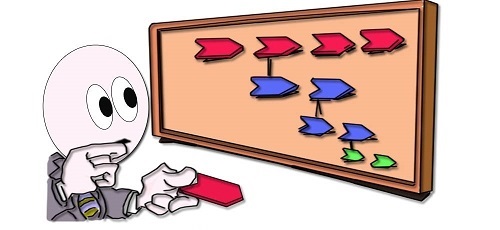
There are two major aspects of project management: the art - directing people on the project and the science - defining and coordinating the work to be done. Gary Heerkens
4.3.1 Governance framework
It is recommended that the governance framework include the principles, policies and frameworks by which the company directs, authorizes and controls the project.
It is important for governance to oversee topics like:
- policies, processes and methods used for project management activities and practices
- framework management (e.g., the project life cycle, see § 4.4)
- roles and responsibilities (e.g., limits for decision-making, see § 4.5)
Responsibility for maintaining project governance is often assigned to the project sponsor (see § 4.5.4) or the project board (see § 4.5.3).
4.3.2 Business case
The business case provides a basis for project governance. It is necessary for the business case to be used to justify the launch and continuation of a project and to include (or reference):
- the objectives to be achieved
- strategic alignment
- the potential profits to be made
- the measures defined to assess the value created
- the company’s acceptable level of risk
- budget, schedule and quality requirements
- disturbances to other company operations
- stakeholder engagement and relationship management
- the use of staff and material resources
- the required skills, knowledge and abilities
- the targeted scope
- the presentation of scenarios
- the proposed management approach
- the ability to maintain business and organizational activities through change
4.4 Life cycle
project life cycle, stages, gates

It is recommended that the following considerations be taken into account when defining the project life cycle:
- organizational and project governance
- the nature of the project
- the risks
- constraints
- internal and external factors
An example of stages and gates (milestones) - G of a project life cycle is shown in Figure 4-3 and the relationships to integrated and project practices.
It is important for each stage to have a beginning and an end, and for each gate (decision point) to be linked to a decision, deliverables and outcomes. Authorization to proceed to the next stage should be linked to the validation of specific criteria.
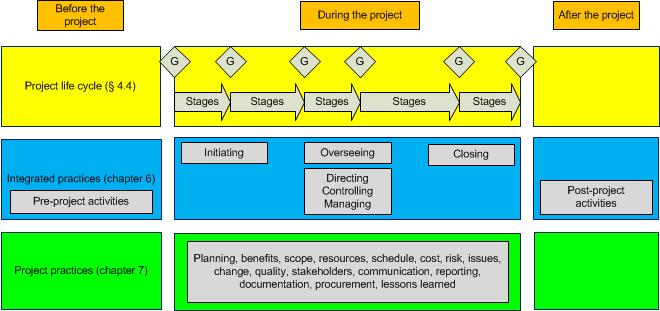
Figure 4-3. Project life cycle, integrated practices and project practices
4.5 Organization
Project organization, sponsoring organization, project board, project sponsor, project manager, workpackage leader, stakeholders
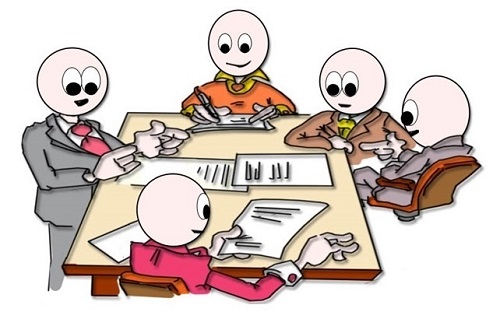
4.5.1 Project organization
Mastering an organization is an art, not a science
 The purpose of project organization is to define the roles, responsibilities and authorities of the stakeholders by giving each role a name.
The purpose of project organization is to define the roles, responsibilities and authorities of the stakeholders by giving each role a name.
The customeranyone who receives a product (see also ISO 9000, 3.3.5), supplier or subcontractor can actively participate in the organization of the project.
The “Define project organization” processactivities which transform inputs into outputs (see also ISO 9000, 3.4.1) is shown in figure 4-4. 

Figure 4-4. The process Define the project organization

- sponsoring organization, § 4.5.2
- project sponsor, § 4.5.4
- project board, § 4.5.3
- project office, § 4.5.7
- work breakdown structure, cf. annex 22

- list of stakeholders, cf. annex 16

- list of activities, cf. annex 24


- define, assign and communicate responsibilities and authorities:
- establish the project organization chart
- establish job descriptions
- determine who is responsible:
- project resources
- the progress of the work
- work overseeing
- validation of work
- reports
- obtain validation from the sponsor

- work package leader, § 4.5.8
- team members, § 4.5.9
- project stakeholders, § 4.5.10
- other roles, § 4.5.11
- reports, § 7.15
- job description, cf. annex 17

- project organization chart, cf. annex 15

- progress report, cf. annex 38

- closing report, cf. annex 47

- inspection report, cf. annex 49


- have you defined the job description of each team member?
- is there a conflict of interest for certain roles?
- who is responsible for monitoring the progress of the work?
- who is responsible for validating the work?
- is the project organization chart updated?
4.5.2 Sponsoring organization
The sponsoring organizationa structure that satisfies a need (see also ISO 9000, 3.3.1) is the higher authority. It provides resources and guidance for the project. The sponsoring organizationa structure that satisfies a need (see also ISO 9000, 3.3.1) is responsible for managing risks and addressing major issues.
For a project within a portfolio or program, the sponsoring organizationa structure that satisfies a need (see also ISO 9000, 3.3.1) may be the portfolio or program manager.
Details on integrated project management practices can be found in chapter 6.
4.5.3 Project board
The project board, if necessary, can contribute to the project by providing guidance and advice to the project sponsor. The project board may include:
- a governing body, a higher authority to which the project sponsor is responsible (accountability)
- a board, chaired by the project sponsor, which provides high-level advice
The project board should:
- monitor the progress and prospects of the project to confirm that the interests of the company are respected
- provide a forum to contribute to strategic decisions, remove obstacles and resolve issues
If a project is common to two companies, the project board may include representatives from each company.
4.5.4 Project sponsor
The project sponsor has the obligation to report to the higher authority on the achievement of the project objectives, the achievement of outcomes and the realization of the required benefits.
The project sponsor should be the pilot or manager of the business case and be responsible for the governance of the project, including audits, reviews and assurance (see ISO 21505).
Examples of project sponsor responsibilities:
- validate the justification of the project throughout its life cycle
- confirm the qualification and competence of the project manager and his team
- provide the project manager with decisions, guidance and advice to meet the business need
- confirm the company's preparation and commitment to organizational or societal change and that change is occurring (see § 7.14)
- resolve the issues to be addressed and the risks that have arisen
- involve key stakeholders
- make decisions within delegated authority
- report risks and issues to be addressed to higher authority
- implement the cultural and ethical aspects of the project
The project sponsor can be a member of the project board.
4.5.5 Project assurance
Although the project sponsor is responsible for audits, reviews, and assurance, these activities may be assigned to one or more individuals independent of the project manager.
4.5.6 Project manager
The project manager has the obligation to report to the project sponsor or the project board on the definition of the scope, on the leadership and on management of the project team.
Examples of project manager activities:
- establish the management approach in accordance with the agreed governance approach
- motivate the project team
- ensure daily verification
- demonstrate leadership
- define the team's approach, responsibilities, scope of work and objectives
- monitor, forecast and report overall progress against project planning (see § § 7.2 and 7.15)
- manage risks (see § 7.8) and issues (see § 7.9);
- control and manage project changes (see § 7.10);
- manage supplier performance as defined in the relevant contracts (see § 7.17);
- ensure that stakeholder engagement (see § 7.12) and communication (see § 7.13) take place as planned
- validate the deliverables and results provided by the project
The project manager can be assisted by a project management team on planning, cost control and quality.
4.5.7 Project office
The project office, if necessary, can have its role, responsibilities and reporting management defined.
Examples of activities that a project office can perform to support the project manager and the project team:
- carry out analyzes
- define and administer governance
- standardize project methods and processes
- train in project management
- plan and carry out follow-ups
- manage information
- provide administrative support
A project office can also support multiple projects and manage programs or portfolios.
A project office can also take on roles such as project manager, project sponsor and project board, and act as a center of competence or center of excellence in project management.
4.5.8 Work package leader
A work package leader has an obligation to report to the project manager on the direction, management and delivery of assigned outputs or outcomes, as defined in a work package. The work package leader or team leader may be part of the sponsoring organizationa structure that satisfies a need (see also ISO 9000, 3.3.1) or a third-party organizationa structure that satisfies a need (see also ISO 9000, 3.3.1), such as a subcontractor.
Examples of work package leader responsibilities:
- confirm that work packages are completed to the required quality, on time and within budget
- contribute to and review important management documents
- plan, monitor, forecast and report overall progress against the work package plan
- manage the resolution of risks and issues to be addressed and escalate those that exceed the level of decision-making authority
- manage changes to the work scope and request authorization for changes that are outside of their authority
- manage and optimize the use of resources
- deliver final outputs to the project team or project manager
The project manager may assume the role of work package leader.
4.5.9 Team members
Project team members carry out project activities and are accountable to the work package leader or project manager regarding the completion of their assigned activities and resulting deliverables.
4.5.10 Stakeholders
Project stakeholders are people, groups, or organizations that have interests in, can affect, be affected by, or perceive themselves to be affected by any aspect of the project. Project stakeholders can be internal or external to the project and the company.
Examples of stakeholders:
- shareholder
- customer
- project board
- project sponsor
- employee
- sponsoring organization
- supplier
- finance provider
- interest group
- member of the project team
- governing body
- certification body
- business partner
- project manager
- work package leader
- user
4.5.11 Other roles
Other roles may be defined depending on the needs of the work required.
Examples may include those managing output development, agile roles such as delivery, service and operation management, organizational and societal change, communications, and various engineering disciplines.
4.6 Competence
Project staff competence, manage skills, project manager competence
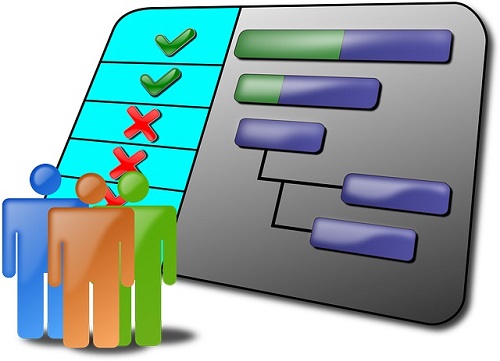
You should adapt people's missions to their Talents, not their skills to their position. Jacques Lebeau
Examples of project staff competence:
- technical skills as concepts and practices, in order to lead, manage, plan and carry out a project in a structured way
- behavioral skills associated with personal relationships such as leadership, team building, people management, coaching, negotiation and conflict management
- business and other skills related to project management in the organizational, contractual and external environment
Project team members not directly involved in project management should be competent (roles and responsibilities) in a relevant area.
It is recommended to consider any gap between required and available skills as a constraint or risk to the project. The skills and abilities of team members can be improved or increased through ongoing personal and professional development.
 The purpose of the “Manage competence” processactivities which transform inputs into outputs (see also ISO 9000, 3.4.1) is to monitor and optimize the performance of team members. The processactivities which transform inputs into outputs (see also ISO 9000, 3.4.1) is shown in figure 4-5.
The purpose of the “Manage competence” processactivities which transform inputs into outputs (see also ISO 9000, 3.4.1) is to monitor and optimize the performance of team members. The processactivities which transform inputs into outputs (see also ISO 9000, 3.4.1) is shown in figure 4-5. 
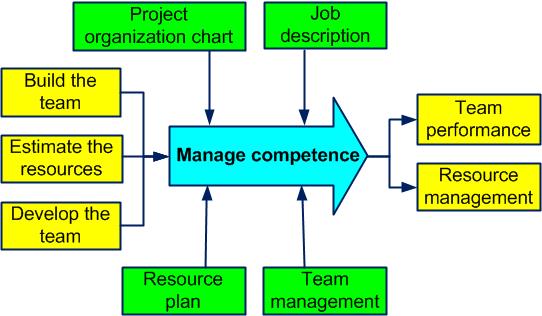
Figure 4-5. The Manage Skills process

- estimate the resources

- build the team

- develop the team

- project organization chart, cf. annex 15

- job description, cf. annex 17

- resource plan, cf. annex 25


- select team members with appropriate skills
- define the moment of integration and the moment of exit of the team
- update team members, if necessary
- establish good mutual communication
- create the conditions favoring the involvement, motivation and consolidation of the team
- establish the ethical rules to follow
- encourage everyone’s participation
- consult team members on:
- ideas
- suggestions
- problems
- process feedback regarding the team
- help develop skills
- resolve issues related to team members
- improve communication within the team
- appreciate the team’s performance

- team performance
- resource management, cf. § 7.5
- list of team members, cf. annex 18

- team performance, cf. annex 42

Everyone knows that personnel are the main condition for the success of a project. But are we paying enough attention to each person's needs, desires, wishes and concerns every day? How do we help each member connect their work to the customeranyone who receives a product (see also ISO 9000, 3.3.5)'s final smile?
The first responsibility of a leader is to define reality. The last is to say “thank you”. Between the two, the leader is a servant. Max de Pree
Responsibilities of the project manager (project leader) in relation to:
- the project:
- define:
- the goal
- functional requirements
- the objectives
- the plan
- develop:
- the schedule
- the budget
- respect:
- deadlines
- prices
- quality
- monitor performance via regular reviews
- validate and communicate documents
- define:
- to the organization:
- communicate regularly with:
- the team
- top management
- control the changes
- detect weak signals of future concerns very early
- monitor and report progress
- control risks
- communicate regularly with:
- to the team:
- choose and appoint team members
- unite the team to solve problems
- coordinate the work
- overcome obstacles
- inform about:
- the project
- the roles of each member
- requirements
- constraints
- facilitate the development of each member
- recognize the work accomplished
- guarantee the right to make mistakes
- participate in decisions
- to the customer:
- talk about needs and not solutions
- clarify requirements as early as possible
- know:
- customer priorities
- their level of satisfaction
- inform the customer regularly
- to stakeholders:
- identify all stakeholders
- obtain the support of stakeholders as soon as possible
- establish partnerships with suppliers and subcontractors
Project managers don’t create anything: they produce efficiency. Louis Schweitzer
Skills of the project manager (project leader, project responsible):
- in leadership:
- give the example:
- honesty
- integrity
- experience
- trust
- enthusiasm
- lead the team like a conductor
- assess customer needs
- pilot:
- quality
- the budget
- the schedule
- create the project overview
- manage:
- production
- human relations
- the risks
- uncertain situations
- conflicts
- ambiguous signals
- contradictory data
- uncertainty
- meet the conditions for the team’s involvement
- negotiate
- clarify roles
- know how to:
- use common sense
- take a step back
- think before acting
- communicate clearly and easily
- coordinate
- find the balance between:
- rigor and flexibility
- the permit and constraints
- delegate
- lead a meeting
- surround yourself with experts
- resolve problems, cf. annex 23

- help and support
- tolerate mistakes
- accept and apply changes
- make the most of lessons learned
- have a positive attitude
- always be available
- give the example:
- in the project process:
- transform:
- an idea into requirements
- requirements into objective
- master the:
- project management tools
- techniques of:
- planning
- risk control
- systems
- methods
- always know how to:
- answer the question “why?”
- justify your choices
- work in a team
- report to:
- the sponsor
- top management
- transform:
- in technology:
- master project management software
- develop and design
- industrialize:
- prototypes
- initial samples
- mass production
- document the steps (stages)
- validate and keep all working documents up-to-date
- in corrective actions:
- know how to choose the right time (neither too early nor too late)
- clearly communicate the problem
- encourage participation of team members
- support suggestions
The difference between project manager and department head is that a project is always unique and always limited in time. The project manager ensures the conditions in which staff will be involved and motivated. These people come from different departments, have different specialties and often the project manager does not have obvious administrative authority over them.
The project manager uses different tools without moderation. Many books are exclusively devoted to project management tools and methods, cf. § 2.3. See also the project tools in annex 09. 
When the project is a success, it is the responsibility of the entire team. When it is a failure, it is the responsibility of the team leader
It's the legend of the pig and the chicken wanting to open a restaurant. The name proposed by the chicken was: Ham and Eggs. After reflection, the pig refused, justifying that he should not have to commit while the chicken was getting involved.
Moral: there is a difference between commitment and involvement. Committing means being responsible (deciding and answering for your actions); getting involved means making a one-off contribution (an egg).
 Example of a complete team:
Example of a complete team:
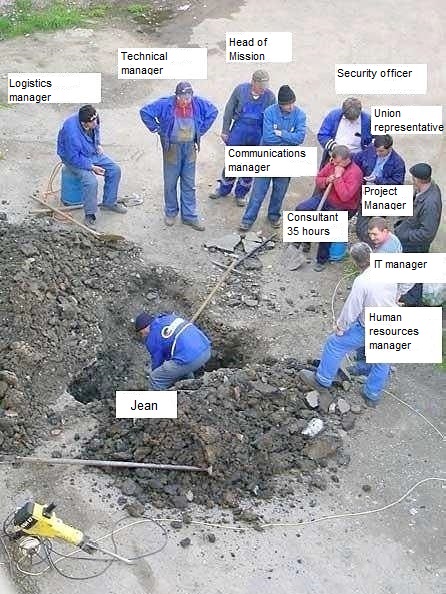

- how do you select team members?
- what training must certain team members follow?
- does the candidate have, for this job:
- the qualification
- knowledge
- skills
- experience
- does the candidate have the desire and attitude to join the team?
- does the candidate understand and accept the job description?
- is the candidate compatible with the corporate culture?
- how does each member know their responsibilities and authorities?
- are all the necessary skills reunited?
- how do you manage changes in staff competence requirements?
- what conditions promote the motivation of team members?
 Minute of relaxation. Cf. the “Every Wednesday?" joke.
Minute of relaxation. Cf. the “Every Wednesday?" joke.
